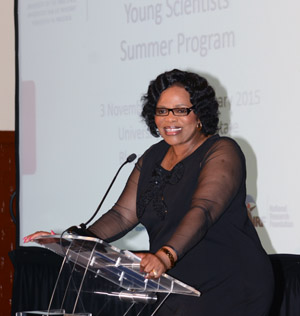
Deputy Minister of Science and Technology, Zanele Magwaza-Msibi
Photo: Stephen Collett |
Students from all over the world and all walks of life have come together at the Bloemfontein Campus to take part in the Southern African Young Scientists Summer Programme (SA-YSSP) hosted by our university.
This prestigious academic programme is an annual three-month education, academic training and research capacity development programme. The programme is presented in collaboration with the International Institute for Applied Systems Analysis (IIASA) as well as the National Research Foundation.
Dr Priscilla Mensah, Director of the SA-YSSP, says this programme’s Doctoral candidates are given the opportunity to advance their research under the direct supervision of senior scientists from South Africa and IIASA.
“In line with international trends in doctoral education, the SA-YSSP seeks to advance not only the discipline-specific research skills of the young scientists, but also equip and expose scholars to an array of additional competencies and skills required to be successful in knowledge-driven societies,” Dr Mensah says.
During her keynote address, Deputy Minister of Science and Technology, Zanele Magwaza-Msibi, praised the UFS for hosting this successful programme for the third year. “The success of this programme shows in the increase in applicants internationally but specifically in our SADEC regions.”
She said that solutions to the problems in the world require a wide variety of knowledge and integrated approaches to the unique challenges in different countries.
Deputy Minister Magwaza-Msibi also regards the SA-YSSP as a very successful platform to strengthen partnerships with countries.